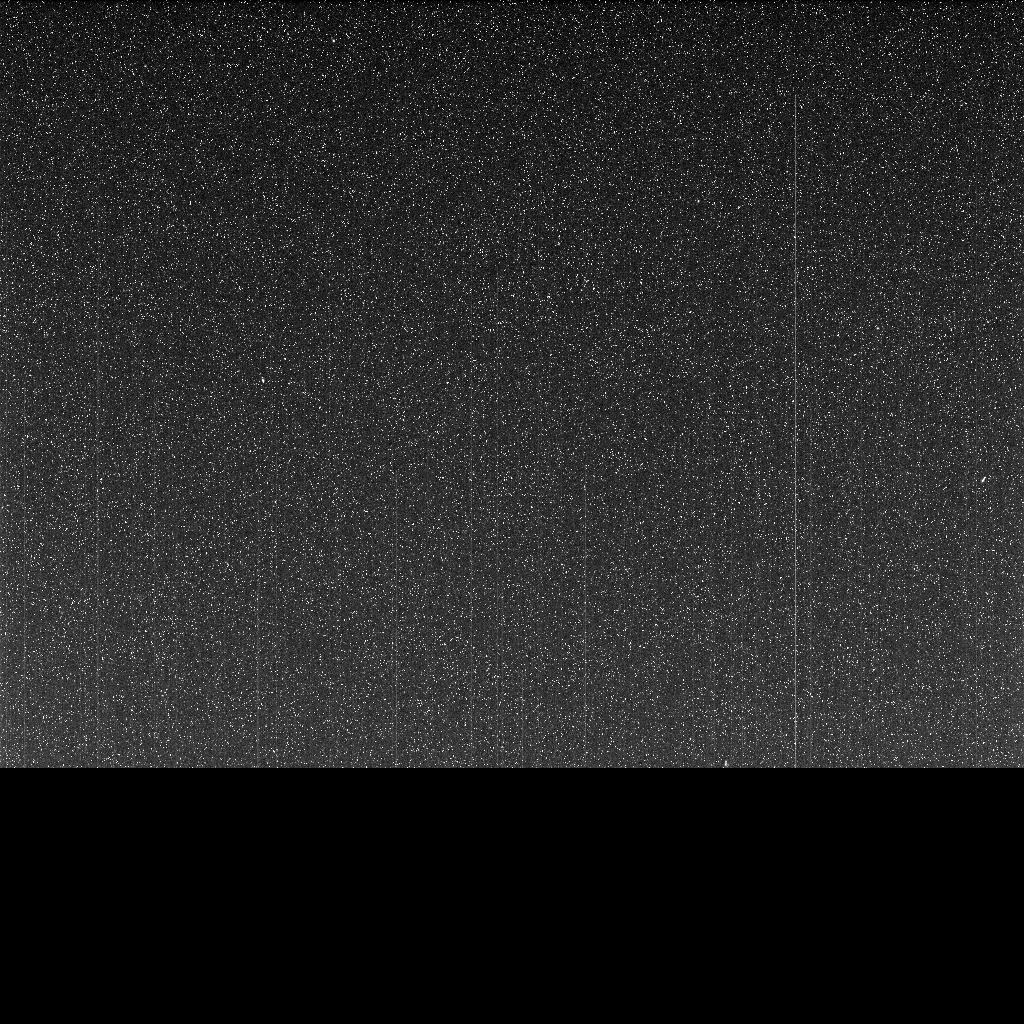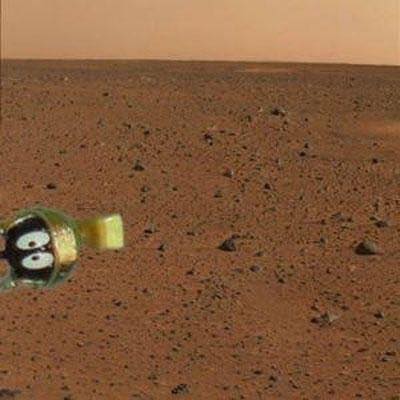It looks like you're using an Ad Blocker.
Please white-list or disable AboveTopSecret.com in your ad-blocking tool.
Thank you.
Some features of ATS will be disabled while you continue to use an ad-blocker.
17
share:
The picture doesn't show anything particularly interesting but it is a poignant reminder of a lost friend for any Mars explorers who followed the
mission through its 14 years of discovery and all those Blueberries.

It's hard to believe it's been 12 months since we lost our longest serving Mars rover following a global dust storm that robbed Opportunity of its vital connection to the Sun but as her power drained Opportunity continued to work right up to the end.
The picture was taken using the left half of Opportunity's Panoramic Camera , it's so dark because of the dust storm and because the camera had its solar filter on at the time , the black bar at the bottom is because Opportunity didn't have the power to send the complete image , the picture shows the point of Opportunity's death.

It's hard to believe it's been 12 months since we lost our longest serving Mars rover following a global dust storm that robbed Opportunity of its vital connection to the Sun but as her power drained Opportunity continued to work right up to the end.
The picture was taken using the left half of Opportunity's Panoramic Camera , it's so dark because of the dust storm and because the camera had its solar filter on at the time , the black bar at the bottom is because Opportunity didn't have the power to send the complete image , the picture shows the point of Opportunity's death.
The image was captured on the 5,111th Martian Sol, in the Perseverance Valley. It was captured at about 9:30 am PDT (4:30 pm UTC) on June 10, 2018, just over one year ago.
It transmitted the image up to the Mars Reconnaissance Orbiter at about 9:45, then on to Earth. It arrived here at about 10:05 am PDT (5:05 pm UTC), where it was received by one of the stations in NASA's Deep Space Network.
The image is dark because the Sun was blanked out by the global dust storm that enveloped Mars at the time. The graininess is camera noise. The black area at the bottom represents the data that was never received. Opportunity died before it could send the rest.
www.sciencealert.com...
edit on 15-6-2019 by gortex because: (no reason given)
originally posted by: LookingAtMars
a reply to: gortex
That is a sad pic for sure
I couldn't find it with a quick search, but I remember a simulated pic of the position Oppy is stuck in for eternity. Arm stowed and camera facing down.
Not really eternity. I’m sure we’ll get there eventually and build a memorial site around it, complete with plaque and gift shop.
That last picture is a picture of the inside of the mouth of some huge reptilian creature living on mars just before it completely chewed it up.
a reply to: gortex
Buh buh buh... another one bites the dust.
I can emphasize with the original engineers, losing a probe or module is like losing a kid to them boffins. On the other hand these boffins should be proud of themselves-a decade of dedication amounts to a matter of seconds.
They sure beat my space program, where I throw a tennis ball into the sky hoping to hit something.
Buh buh buh... another one bites the dust.
I can emphasize with the original engineers, losing a probe or module is like losing a kid to them boffins. On the other hand these boffins should be proud of themselves-a decade of dedication amounts to a matter of seconds.
They sure beat my space program, where I throw a tennis ball into the sky hoping to hit something.
originally posted by: oriondc
originally posted by: LookingAtMars
a reply to: gortex
That is a sad pic for sure
I couldn't find it with a quick search, but I remember a simulated pic of the position Oppy is stuck in for eternity. Arm stowed and camera facing down.
Not really eternity. I’m sure we’ll get there eventually and build a memorial site around it, complete with plaque and gift shop.
Pretty sure there's an episode on star trek enterprise that has a quick shot of the rover, dead and almost exactly what you describe. Plaque and all.
a reply to: surfer_soul
Sadly not , some of its power was used on heaters to protect it from freezing nighttime temperatures on Mars plus now its mission clock has stopped it has no power to turn itself back on so all hope is lost.
At least we still have the science.
Sadly not , some of its power was used on heaters to protect it from freezing nighttime temperatures on Mars plus now its mission clock has stopped it has no power to turn itself back on so all hope is lost.
At least we still have the science.
edit on 15-6-2019 by gortex because: (no reason given)
a reply to: gortex
I think maybe now SpaceX is on the rise we don't have to wait that long before another rover or maybe the first man will arrive?
But the danger in commercializing missions will probably lead to more secrecy of what they will see on the red planet?
Sadly not , some of its power was used on heaters to protect it from freezing nighttime temperatures on Mars plus it now its mission clock has stopped it has no power to turn itself back on so all hope is lost
I think maybe now SpaceX is on the rise we don't have to wait that long before another rover or maybe the first man will arrive?
But the danger in commercializing missions will probably lead to more secrecy of what they will see on the red planet?
originally posted by: surfer_soul
a reply to: gortex
Can it not power back up when the dust storm passed and re charge from the sun again?
Unfortunately not, the power cells are spent so it cannot retain the power gained from its solar panels. Tis a sad but true fact.
a reply to: 0bserver1
The future is bright mate , Mars 2020 launches this time next year and has a rather special experiment on-board.
Recent Mars news
Can't wait.
The future is bright mate , Mars 2020 launches this time next year and has a rather special experiment on-board.
Recent Mars news
Can't wait.
a reply to: gortex
Wow! How often does Mars have a global dust storm...and why?! Would be really cool to know more about that!
::30 seconds pass::
Aha! It is known! Was wondering if this was a new or known phenomena.
Nasa site - Mars Dust Storms
Wow! How often does Mars have a global dust storm...and why?! Would be really cool to know more about that!
::30 seconds pass::
Aha! It is known! Was wondering if this was a new or known phenomena.
Nasa site - Mars Dust Storms
Decades of Mars observations show a pattern of regional dust storms arising in northern spring and summer. In most Martian years, nearly twice as long as Earth years, the storms dissipate. But we’ve seen global dust storms in 1971, 1977, 1982, 1994, 2001 and 2007. The current storm season could last into 2019.
edit on 6/15/2019 by dogstar23 because: Trying to fix link
new topics
-
D.B. Cooper mystery may be solved
General Conspiracies: 4 hours ago
top topics
-
D.B. Cooper mystery may be solved
General Conspiracies: 4 hours ago, 13 flags
active topics
-
D.B. Cooper mystery may be solved
General Conspiracies • 20 • : Flyingclaydisk -
I thought Trump was the existential threat?
World War Three • 82 • : Xtrozero -
Interesting Video-UFO?
Aliens and UFOs • 17 • : Flyingclaydisk -
Well, here we go red lines crossed Biden gives the go ahead to use long range missiles
World War Three • 398 • : andy06shake -
How Long have You been Alive?
General Chit Chat • 34 • : Flyingclaydisk -
Mood Music Part VI
Music • 3717 • : BrucellaOrchitis -
Federal law trumps state and local law every time
Social Issues and Civil Unrest • 31 • : fringeofthefringe -
Petition Calling for General Election at 564,016 and rising Fast
Political Issues • 97 • : BrucellaOrchitis -
Joe Biden Dabs Away Tears at Farewell White House Dinner
Politicians & People • 27 • : chr0naut -
Results of the use of the Oreshnik missile system in Dnepropetrovsk
World War Three • 241 • : andy06shake
17

